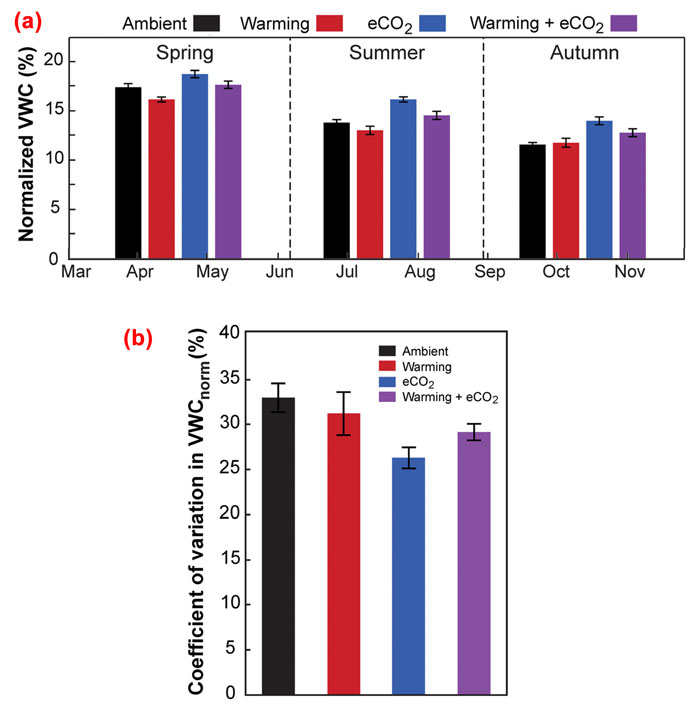The Combined Effects of Elevated CO2 and Warming on the Soil Water Content of a Mixed-prairie Grassland
Paper Reviewed Blumenthal, D.M., Mueller, K.E., Kray, J.A.,LeCain, D.R., Pendall, E., Duke, S., Zelikova, T.J., Dijkstra, F.A., Williams, D.G. and Morgan, J.A. 2018. Warming and elevated CO2 interact to alter seasonality and reduce variability of soil water in a semiarid grassland. Ecosystems 21: 1533-1544. Introducing their work, Blumenthal et al. (2018) write that “global changes that alter soil water availability may have profound effects on semiarid ecosystems,” adding that “although both elevated CO2 and warming can alter water availability, often in opposite ways, few studies have measured their combined influence on the amount, timing, and temporal variability of soil water.” Consequently, they set out to conduct just such an experiment. More specifically, they investigated the impacts of elevated CO2 and temperature warming on soil water availability of a North American mixed-grass prairie over the years 2007-2012. The study site was the Prairie Heating and CO2 Enrichment (PHACE) located 15 km west of Cheyenne, Wyoming, USA. The site consisted of native undisturbed mixed-grass prairie composed of C3 graminoids, C4 grasses and a variety of forbs and shrubs. The four treatments in the PHACE experiment included (1) ambient CO2 and ambient temperature, (2) elevated CO2 and ambient temperature, (3) elevated temperature and ambient CO2 and (4) elevated temperature and elevated CO2. Elevated temperatures were maintained using infrared heaters at +1.6°C above ambient during the day and 3.0°C at night. Elevated CO2 concentrations were kept at 600 ppm during daylight hours of the growing season (when the site was not covered with snow). So what effect did elevated CO2 and elevated temperature have on soil water content? As shown in Figure 1a below, the response of normalized volumetric soil water content (VWCnorm) to elevated CO2 was “consistently positive” across the spring, summer and autumn months of study. In contrast, elevated temperature reduced VWCnorm in the spring and summer, but had no effect in the autumn. In the combined elevated CO2 and elevated temperature treatment, the positive effects of elevated CO2 were more than adequate to negate the negative effects of warming on the soil water content, in all seasons producing VWCnorm percentages that were higher than that observed in the control treatment. The net increases in soil water content was not the only benefit of elevated CO2 observed by Blumenthal et al. As seen in Figure 1b, the authors report that elevated CO2 “also led to a reduction in the daily coefficient of variation of VWCnorm from 32 to 28%.” Such reduced temporal variability occurred primarily because of improved plant water use efficiencies under elevated CO2, which increased the soil water content during drier conditions. In conclusion, the authors write that their results suggest that “elevated CO2 and warming will combine to yield modest increases in both soil water and plant productivity,” adding that their findings are “also in accord with suggestions that models that do not incorporate elevated CO2 may underestimate future grassland productivity.”
 Figure 1. Panel (a): Effects of warming and elevated CO2 (eCO2) on normalized soil volumetric water content (VWCnorm) at 5-25 cm depth in spring (Mar 14-Jun 6), summer (Jun 7-Aug 30), and autumn (Aug 31-Nov 22). Panel (b): Effects of warming and eCO2 on VWCnorm at 5-25 cm depth. All data represent an average of 6 years (from 2007-2012). Source: Blumenthal et al. (2018).
Figure 1. Panel (a): Effects of warming and elevated CO2 (eCO2) on normalized soil volumetric water content (VWCnorm) at 5-25 cm depth in spring (Mar 14-Jun 6), summer (Jun 7-Aug 30), and autumn (Aug 31-Nov 22). Panel (b): Effects of warming and eCO2 on VWCnorm at 5-25 cm depth. All data represent an average of 6 years (from 2007-2012). Source: Blumenthal et al. (2018).